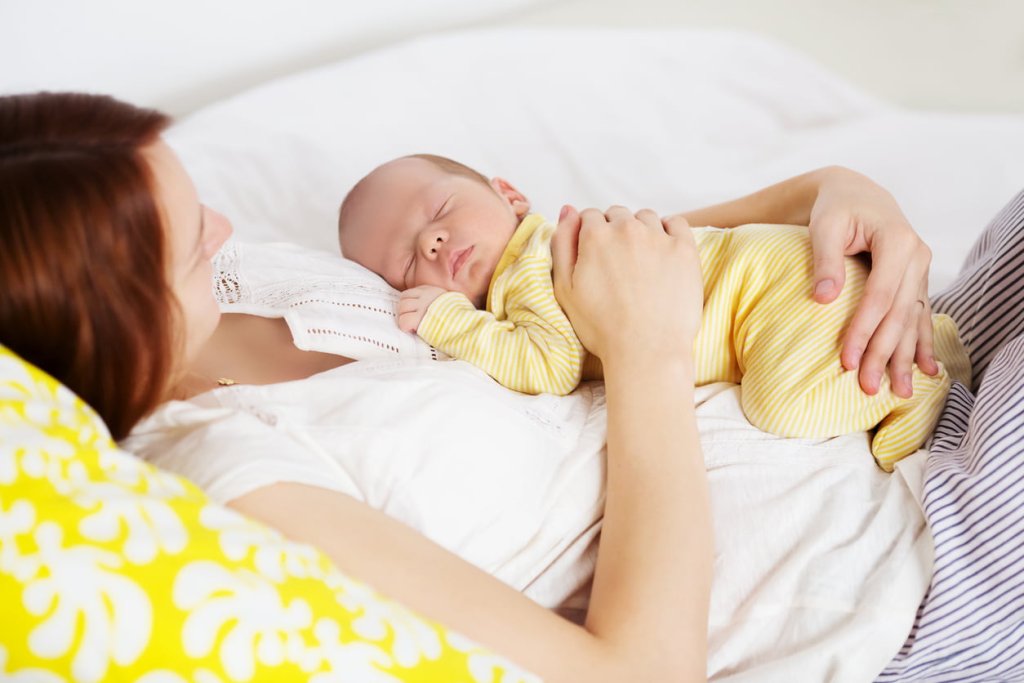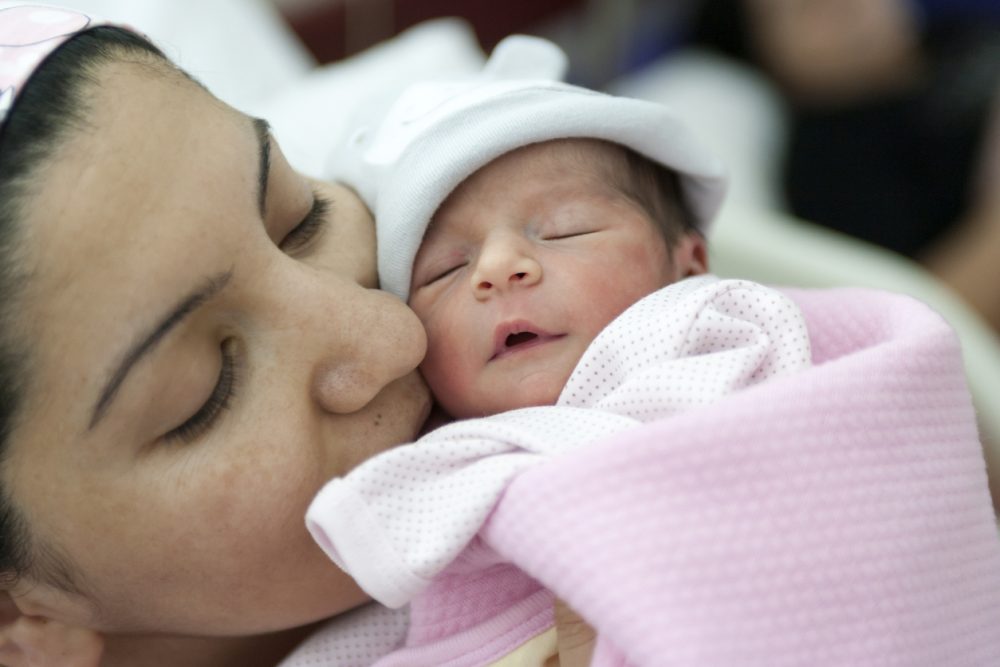In this blog for women preparing for, or after, childbirth, Jennifer Hanratty looks at what research tells us about what might help for perineal pain, and shares her own experience as a new mum.
Page last updated 28 February 2023.
I had a plan. I had a well-researched and referenced plan. I wasn’t going to be induced. I was going to have a peaceful hypnobirth in water. No episiotomy for me. No interventionA treatment, procedure or programme of health care that has the potential to change the course of events of a healthcare condition. Examples include a drug, surgery, exercise or counselling. required thank you. I got this…
…until 14 days after my estimated due date, feeling bullied and vulnerable I tearfully agreed to have labour induced. The pessary did the trick and all was calmly proceeding until a last minute scramble out of the lovely midwife-led suite, away from the unused birthing pool, up in the lift to the labour ward. My husband, to his eternal credit, tried to object when an episiotomy was suggested. In that moment all I wanted was for everyone to leave me alone and if an episiotomy would get rid of this lovely team of medics quicker then so be it. So my journey into motherhood began with a bruised, torn, cut and stitched perineum.
The perineum and childbirth
If you are unfamiliar with the perineum it is the diamond shaped bit of skin and muscle in between the vagina and the anus. It’s the bit that will (brace yourselves ladies) often tear and occasionally be cut (an episiotomy) during a vaginal birth to allow baby to emerge into the world. There are varying degrees of damage – ranging from bruising and small tears that heal on their own, through to serious 4th degree tears that require surgical repair (thankfully these are rare).
Many women who give birth vaginally will suffer some form of perineal pain in the postpartum (after birth) period, even those lucky few with no tear. In the days after birth with so much going on with your body – and the small person that came out of it – we will want to manage that pain.
But what forms of pain relief work best? Which are easiest on our amazing and exhausted postpartum bodies? Which can be taken safely while breastfeeding? Can different forms of pain relief be safely combined? These are the questions I had when approaching a series of three Cochrane ReviewsCochrane Reviews are systematic reviews. In systematic reviews we search for and summarize studies that answer a specific research question (e.g. is paracetamol effective and safe for treating back pain?). The studies are identified, assessed, and summarized by using a systematic and predefined approach. They inform recommendations for healthcare and research. on managing perineal pain, using aspirin, paracetamol, or non-steroidal anti-inflammatory drugs (NSAIDs) like ibuprofen.
Painkillers for perineal pain: effective and safe?
The Cochrane Review Paracetamol for relief of perineal pain after birth (updated in January 2021) concludes that a single dose of paracetamol may reduce the number of women in pain four hours after birth. Possible harms for women and babies were not adequately assessed.
The Cochrane Reviews on Aspirin (single dose) for relief of perineal pain after childbirth (July 2020) and on non-steroidal Anti‐inflammatory drugs for relief of perineal pain after childbirth (January 2021) find that both may provide adequate pain relief and may reduce need for additional pain relief four hours later when compared to placeboAn intervention that appears to be the same as that which is being assessed but does not have the active component. For example, a placebo could be a tablet made of sugar, compared with a tablet containing a medicine., but trialsClinical trials are research studies involving people who use healthcare services. They often compare a new or different treatment with the best treatment currently available. This is to test whether the new or different treatment is safe, effective and any better than what is currently used. No matter how promising a new treatment may appear during tests in a laboratory, it must go through clinical trials before its benefits and risks can really be known. were low quality and poorly reported. Crucially, those who were breastfeeding were excluded from trials of aspirin and NSAIDs. This evidence therefore may not apply to the roughly 81% of women who initiate breastfeeding within the first hour of birth. We don’t know if aspirin or NSAIDs are safe or effective for the majority of women and their babies.
No trials in any of the three reviews reported neonatal outcomesOutcomes are measures of health (for example quality of life, pain, blood sugar levels) that can be used to assess the effectiveness and safety of a treatment or other intervention (for example a drug, surgery, or exercise). In research, the outcomes considered most important are ‘primary outcomes’ and those considered less important are ‘secondary outcomes’. and none reported on safetyRefers to serious adverse effects, such as those that threaten life, require or prolong hospitalization, result in permanent disability, or cause birth defects. for breastfeeding mothers, impacts on breastfeeding, post-partum depression, prolonged perineal pain or acceptability of the drugs. That’s a lot of important questions that remain unanswered.
We need to know what is safe for breastfeeding mothers to remove any barriers to successfully initiating and maintaining breastfeeding. Have you tried breastfeeding round the clock when you can’t get comfortable sitting down? Or even simply sitting up to lift baby in and out of their safe sleeping space (UNICEF) in or beside your bed? It’s not easy.
Alternatives to drugs to relieve perineal pain
My other question is what non-drug options are there for pain relief? Well, according to this Cochrane Review Local cooling for relieving pain from perineal trauma sustained during childbirth (October 2020), cooling the area with ice-packs, cooled gel pads or sitting in an ice bath (shudder) may relieve perineal pain. I almost hugged my midwife when she produced a bowl of gauze pads soaked in water and witch hazel from the fridge. Oh the relief.

A safe alternative to taking the drugs is doing nothing more than getting a comfortable position. My go-to daytime position was reclined on the sofa with feet up on a footstool or a big gym ball to relieve the pressure on the area. A comfy position is especially important for cluster feeding when baby wants to be latched on for hours in the evenings. Mastering laid back feeding and side lying feeding is also a godsend to get more rest. Although side lying feeding can end up replacing the pain in your perineum with pain in the neck and shoulders, so try to take a moment to get yourself comfy before latching baby.
Another vital part of a new Mum’s toolkit for dealing with perineal pain is to have someone at home who can bring you water, snacks and the remote control so you don’t have to move once you get situated. Toddlers are good at this and it helps them feel involved.
Change maternity pads frequently to reduce riskA way of expressing the chance of an event taking place, expressed as the number of events divided by the total number of observations or people. It can be stated as ‘the chance of falling were one in four’ (1/4 = 25%). This measure is good no matter the incidence of events i.e. common or infrequent. of infection. Supporting the area while going to the loo can give you confidence if you’re worried about stitches tearing. Stay in your PJs or a comfy nightdress for the first few days to minimise irritation to the area. Don’t be getting dressed for the midwife or health visitor, they’ll understand you’ve got bigger priorities.
If you do need pain relief check what is safe for you and your baby in the post-partum period (for example the Breastfeeding Network’s Factsheet about painkillers) before taking it. Information for GPs on safety of medications while breastfeeding and other very useful resources for healthcare professionals to support women in their feeding choices can be found on the GP Infant Feeding Network website.
Preventing perineal pain
If you’re currently expecting (or indeed supporting women in labour) then really prevention is better than cure in this case. A number of methods have been identified as effective for reducing the risk of perineal trauma and episiotomy, during vagina birth.
The Cochrane Review on Antenatal perineal massage for reducing perineal trauma (April 2013) reports that perineal massage reduces risk and degree of tear and episiotomy, with a clear benefit for first time mothers in particular. Perineal massage, undertaken by the woman or her partner, for as little as once or twice a week from 35 weeks can be effective.
Having the perineum supported with a warm compress during second stage labour (the pushing part), rather than no warm compress or no perineal support, probably results in fewer women having 3rd and 4th degree tears according to this Cochrane Review Perineal techniques during the second stage of labour for reducing perineal trauma (June 2017) and frankly sounds quite pleasant to me. It probably made no difference to the number of women not tearing at all and it’s unclear whether it made a difference to the likelihood of small tears.
Perineal massage during second stage labour probably also reduces 3rd and 4th degree tearing and may increase the number of women with no tears, but it’s not quite so appealing as a nice warm compress. Episiotomy is routinely practiced and may not actually be necessary (I really wish I’d listen to my husband). Routine episiotomy is not recommended and a selective episiotomy policy will result in fewer women with severe perineal/vaginal trauma, finds the Cochrane Review Selective versus routine use of episiotomy for vaginal birth (February 2017). Finally, the Cochrane Review on Women’s position for giving birth without epidural anaesthesia (May 2017) has evidence that birthing in an upright position, like on hands and knees, may help reduce perineal trauma compared to lying on your back.
I felt like applauding (ok I admit I clapped at my laptop) when reading Chou et al’s conclusion that “Perineal pain following childbirth …suffers from lack of research and clinical attention while remaining a major focus for mothers and their families.” They are absolutely right. This is really important. It really hurts. It really can interfere with a person’s wellbeing, at a time when they are already vulnerable, exhausted and often overwhelmed. We deserve better than poorly conducted, badly reported trials that are irrelevant to most of us.
Jennifer Hanratty has nothing to disclose. Views are Jennifer’s own.



[…] Perineal pain after birth: what can help, Evidently Cochrane […]
i had episotomy during my labor 4 month ago. I have some vibration like movement in my vagina, my stitches didnt healed well and also have itching and parasite like movt arround my rectum. i feel like sweelling in my veins sometimes and it disappears. i dont feel ok. there is discomfort. what can i do?
Hello, I’m afraid we can’t advise. This is something to discuss with your doctor.
Best wishes,
Sarah Chapman [Editor].
Jennifer!! I feel your pain, your experience was similar to mine six days ago, I was 41wks 5days and while I narrowly avoided induction, I was pushing for 3hrs and they told me episiotomy or cesarean. In my Birth fog I said episiotomy no drugs…. so they cut me THREE TIMES. As my little one was being suctioned at this point, I just remember thinking I need to help her out as quickly as possible so they don’t do more “routine” stuff to her. I found your article on google because my pain is beyond ok right now down there but I’m trying so hard to not give in to big Pharm for relief.
I birthed at a hospital we were not planning on using (conventional vs the much more natural friendly hospital down the road) but I was 9c in 6hrs so we couldn’t hv made it to the other location. Sadly My doula thinks medical intervention was pushed to soon and the experience of birthing in a conventional hospital with a natural birth plan was completely foreign to half the medical staff in the room. My baby girl is healthy and exclusively BF and we are home so we are grateful for that but THANK YOU for your article.